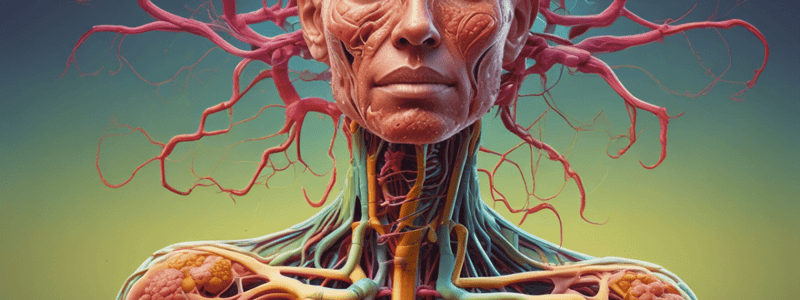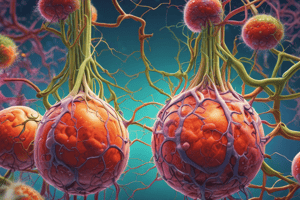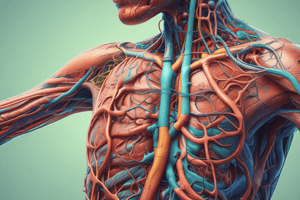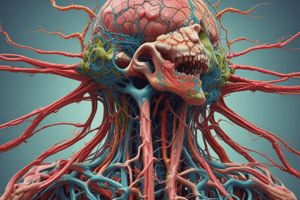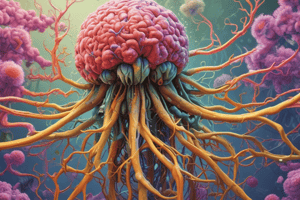Podcast
Questions and Answers
What is the primary function of the lymphatic system?
What is the primary function of the lymphatic system?
- To produce red blood cells
- To transport oxygen and nutrients throughout the body
- To filter pathogens from the blood (correct)
- To control body temperature
What type of cells make up the walls of lymphatic capillaries?
What type of cells make up the walls of lymphatic capillaries?
- Smooth muscle cells
- Adipose cells
- Simple squamous endothelial cells (correct)
- Cuboidal epithelial cells
Which of the following organs is NOT part of the lymphatic system?
Which of the following organs is NOT part of the lymphatic system?
- Lymph nodes
- Thymus
- Cornea (correct)
- Spleen
What is the role of B cells in the adaptive immune response?
What is the role of B cells in the adaptive immune response?
How does lymph move through the lymphatic system?
How does lymph move through the lymphatic system?
Which of the following is NOT a function of the lymphatic system?
Which of the following is NOT a function of the lymphatic system?
Where do B cells develop?
Where do B cells develop?
What is the primary function of T cells?
What is the primary function of T cells?
Which immune cells are considered the first line of defense against viruses and some cancers?
Which immune cells are considered the first line of defense against viruses and some cancers?
Where do T cells mature?
Where do T cells mature?
Which organs are classified as secondary lymphoid organs?
Which organs are classified as secondary lymphoid organs?
What is the function of lymph nodes?
What is the function of lymph nodes?
What is the role of dendritic cells and macrophages in the spleen?
What is the role of dendritic cells and macrophages in the spleen?
Where are mucosa-associated lymphoid tissue (MALT) found?
Where are mucosa-associated lymphoid tissue (MALT) found?
What happens when tonsils swell?
What happens when tonsils swell?
Which lymphoid structure is a dense cluster of lymphocytes without a fibrous capsule?
Which lymphoid structure is a dense cluster of lymphocytes without a fibrous capsule?
What is the distinctive feature of germinal centers in lymphoid structures?
What is the distinctive feature of germinal centers in lymphoid structures?
What is the role of dendrites in the immune system?
What is the role of dendrites in the immune system?
What is the main function of Helper T cells?
What is the main function of Helper T cells?
What is the significance of clonal expansion in the immune response?
What is the significance of clonal expansion in the immune response?
What is the outcome of negative selection during T cell maturation?
What is the outcome of negative selection during T cell maturation?
Which type of T cell is responsible for killing target cells by inducing apoptosis?
Which type of T cell is responsible for killing target cells by inducing apoptosis?
What is the primary role of B cells in the immune system?
What is the primary role of B cells in the immune system?
What is the primary function of bronchus-associated lymphoid tissue (BALT)?
What is the primary function of bronchus-associated lymphoid tissue (BALT)?
Which of the following statements about the innate immune response is true?
Which of the following statements about the innate immune response is true?
Which of the following is NOT a barrier defense mechanism?
Which of the following is NOT a barrier defense mechanism?
What is the primary function of natural killer cells in the innate immune system?
What is the primary function of natural killer cells in the innate immune system?
What is the role of pattern recognition receptors in the innate immune system?
What is the role of pattern recognition receptors in the innate immune system?
What is the primary function of the complement system in the innate immune response?
What is the primary function of the complement system in the innate immune response?
What is the primary role of T cells in the adaptive immune response?
What is the primary role of T cells in the adaptive immune response?
What is the difference between class I and class II MHC molecules in antigen presentation?
What is the difference between class I and class II MHC molecules in antigen presentation?
What is the primary function of cytokines in the immune response?
What is the primary function of cytokines in the immune response?
Which of the following is a characteristic of chronic inflammation?
Which of the following is a characteristic of chronic inflammation?
Study Notes
Lymphatic and Immune Systems
- The immune system consists of cells and organs that destroy pathogens, while the lymphatic system consists of vessels, cells, and organs that bring excess fluid to the bloodstream and filter pathogens from the blood.
- Lymph is the interstitial fluid in the lymphatic system, and it is responsible for absorbing dietary lipids and fat-soluble vitamins, which are then transported to the liver through lymphatic vessels.
Anatomy of the Lymphatic System
- The lymphatic system has open-ended capillaries that feed into larger vessels, eventually leading to the subclavian vein.
- Capillaries are composed of simple squamous endothelial cells.
- There are approximately 500-600 lymph nodes located along the lymphatic vessels.
- Lymph movement is not pumped but rather relies on breathing, muscle contraction, and body movements.
- One-way valves ensure that lymph moves towards the heart.
- Areas without lymph vessels include bone marrow, CNS, teeth, and cornea.
Organization of Immune Function
- The immune system has three layers of defense: barrier defenses, innate immune response, and adaptive immune response.
- Barrier defenses prevent invasion, including skin and mucous membranes.
- Innate immune response is rapid but non-specific, consisting of cells such as phagocytic cells and natural killer cells.
- Adaptive immune response is slower but highly specific, involving lymphocytes that coordinate immune responses.
Lymphocytes
- B cells produce plasma cells that bind to specific antigens, leading to antibody production.
- T cells can secrete chemokines to bring other immune cells to the area or destroy cells infected with intracellular pathogens.
- Plasma cells secrete soluble antibodies that bind to specific antigens.
- Natural killer cells have cell-killing granules and are part of the innate immune response.
Lymphoid Organs and Development
- Bone marrow is responsible for B cell development, while the thymus is responsible for T cell maturation.
- Secondary lymphoid organs, including lymph nodes, spleen, and lymphoid nodules, are important for immune response.
- Bronchus-associated lymphoid tissue (BALT) is a type of lymphoid follicle located on the bronchii that is effective against inhaled pathogens.
Barrier Defenses and the Innate Immune Response
- Barrier defenses include skin, sweat, mouth, stomach, mucosal surfaces, and normal flora.
- Innate immune response is rapid but non-specific, involving cells such as macrophages, neutrophils, and natural killer cells.
Innate Immune Cells
- Macrophages are phagocytic cells that cooperate with lymphocytes.
- Neutrophils are phagocytic cells that are attracted to sites of infection through chemotaxis.
- Monocytes differentiate into macrophages or dendritic cells.
- Natural killer cells induce apoptosis in infected cells by releasing perforins and granzymes.
Adaptive Immune Response
- The adaptive immune response is highly specific and involves lymphocytes that coordinate immune responses.
- T cells recognize and attack a wide variety of pathogens, with 100 trillion different receptors.
- Primary adaptive response involves the initial infection, while secondary adaptive response involves immunological memory.
T Cell-Mediated Immune Responses
- T cells recognize antigens on the surface of antigen-presenting cells.
- Antigen presentation involves the cleavage of antigens into small pieces, which are then presented on the membrane attached to a major histocompatibility complex (MHC) molecule.
T Cells
- T cells recognize antigens on the surface of antigen-presenting cells, which can be either professional or non-professional antigen-presenting cells.
- Many human cells can express class I MHC molecules, while only professional antigen-presenting cells can express class II MHC molecules.
Secondary Lymphoid Organs
- Lymph nodes filter lymph and remove debris and pathogens, with dendritic cells and macrophages killing many pathogens.
- Spleen is known as the "filter of the blood" and holds many dendrites and macrophages.
- Lymphoid nodules are dense clusters of lymphocytes found in respiratory and digestive tracts (tonsils).
Development and Differentiation
- T cell tolerance involves the elimination of T cells that might attack one's own body.
- Only 2% of T cells successfully mature from a thymocyte, involving two steps: positive selection and negative selection.
- Positive selection involves the presentation of an MHC molecule, while negative selection involves the presentation of a self-antigen.
Mechanism of T Cell Response
- Clonal expansion involves the rapid division of mature T cells in response to antigen recognition, leading to a strong response against a pathogen.
- Clonal selection involves the process of antigen binding only to the T cell with that specific receptor.
T Cell Types
- Helper T cells secrete cytokines to enhance other immune responses and can be divided into two types: Th1 cells and Th2 cells.
- Th1 cells regulate activity of macrophages and other T cells, while Th2 cells regulate activity of B cell differentiation into plasma cells that make antibody.
- Cytotoxic T cells kill target cells by inducing apoptosis, similar to natural killer cells.
- Regulatory T cells suppress other T cell immune responses.
Studying That Suits You
Use AI to generate personalized quizzes and flashcards to suit your learning preferences.
Related Documents
Description
Test your knowledge on the anatomy of the lymphatic and immune systems, including functions of immune cells, lymphatic vessels, lymph nodes, and the role in absorbing dietary lipids. Explore concepts such as the immune system's response to pathogens and the transportation of lymph in this quiz.
